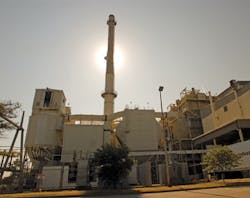Above: Covanta’s Energy-From-Waste facility in Tulsa, Okla., takes wastewater and puts it through a liquid direct injection process.
American Airlines changes the tires on its planes every 60 to 90 days. This presents multiple challenges from a sustainability standpoint. Airlines must handle the rubber from tires that have reached the end of their useful lives and the wastewater generated by cleaning the tires before they are recycled or put back into service. Airplane tires are highly engineered, well-constructed and expensive—more so than any other type of tire. So, what happens to the hundreds of thousands of tires that are no longer usable or need to be cleaned?
In 2014, the American Airlines Wheel and Brake Center in Tulsa, Okla., turned to Covanta Environmental Solutions to sustainably dispose of the dirty wastewater used to clean the airplane tires. The Wheel and Brake Center, striving to improve its recycling programs for many years, was already recycling more than half of its waste in 2014. In fact, sustainability runs in the family—American Airlines recycles 2 million lb of rubber annually from old tires, with some ending up as rubber mulch for playgrounds and sports fields across the country. Yet the team at the Wheel and Brake Center knew that there was an opportunity to become even more environmentally friendly, and decided to pursue a zero-waste-to-landfill strategy.
To achieve zero-waste-to-landfill, it was important for the Wheel and Brake Center to find a partner capable of helping it achieve this sustainability goal in a cost-effective manner. With the help of Covanta, which has an Energy-From-Waste facility located 10 miles away, the Wheel and Brake Center developed a zero-waste-to-landfill strategy and was able to avoid the cost of shipping wastewater long distances and across state lines. The two facilities were a perfect match.
The process of cleaning airplane tires to recover usable rubber produces contaminated wastewater.
Creating Energy From Waste
Worn out and covered with grease, hydraulic fluid, and break dust, the tires processed by the Wheel and Brake Center are both unusable and unfit for disposal. The facility recovers what usable rubber is left by cleaning the tires with a machine similar to a carwash. This process produces wastewater.
Previously, the Wheel and Brake Center treated this wastewater to remove dangerous contaminants, solidified it and disposed of it in a landfill.
Instead of a landfill, Covanta’s Energy-From-Waste facility in Tulsa takes the wastewater from the Wheel and Brake Center and delivers it through a liquid direct injection process, which is designed to destroy contaminants and other materials present in a wide range of waste streams. Covanta’s Tulsa facility added the liquid direct injection process in 2012 as a pilot program after receiving approval from the Oklahoma Department of Environmental Quality.
During the liquid direct injection process, wastewater is pumped through atomizing nozzles directly into advanced controlled combustion chambers. The water is instantly vaporized and the remaining contaminants and materials are destroyed.
With a set of connected tanks, the Covanta Tulsa facility can hold up to 72,000 gal of wastewater as a staging capacity for processing. In 2015, the facility processed approximately 7,147 tons of wastewater through its liquid direct injection process.
This process not only succeeds in avoiding sending additional waste to landfills, it also eliminates potential landfill leachate impacts. The liquid waste is vaporized and destroyed at temperatures approaching 2,000°F in advanced controlled combustion chambers fueled by non-hazardous wastes from homes and businesses. The heat of this combustion process generates a large amount of steam, which is used to generate electricity as well as heat for a local refinery, where it offsets the refinery’s use of fossil fuels.
At the American Airlines Wheel and Brake Center, more than 1 million tons of tire rubber—approximately 25,000 tires a year—are cleaned and returned to service. What’s more, the center can reuse the cleaning water—upwards of 70 tons of wheel wash water each month.
The American Airlines Wheel and Brake Center’s efforts not only make the most of available water and rubber resources, but also reduce landfilling. Landfilling is the least preferable means of handling waste, according to the U.S. Environmental Protection Agency’s waste management hierarchy. Landfills also are the third-largest source of the country’s man-made methane, a gas that has 84 to 86 times more global warming potential than carbon dioxide over a 20-year period.
With 800 tons of wastewater sent to the Energy-From-Waste facility annually, the partnership continues to be successful. In 2015, American Airlines was awarded Sustainable Tulsa’s Henry Bellmon Award for “setting the standards for sustainability in Oklahoma” as a direct recognition for its zero-landfill efforts.


